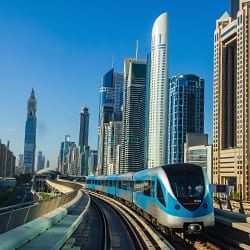In Dubai, around 1.5 million passengers utilize public transportation, 450,000 of whom take the city’s modern and immaculate metro system. It may come as a surprise, then, that women’s-only cabins are available on the metro line. In the Middle East and greater Muslim world, women’s-only public transportation options increasingly have become available. In some countries, such as Jordan, gender segregation in public transport is practiced, but not codified, with women standing at the front of the bus and men at the back. In Dubai, however, gender-segregated transportation options are widely available, clearly marked and strictly enforced. The question remains whether this segregation protects women’s rights and presence in the public sphere, or serves to deepen gender divides.
When the women’s-only cabins were first made available, they were only in operation during peak traffic hours, and just half a cabin was available per train. Currently, there are 30 available seats and standing space for 140 women in two designated cabins per train. The metro police fines approximately 100 men a day for entering the women’s-only cabins, making it the most prevalent offense — surpassing gum chewing or wrongfully taking advantage of the gold class cabin.
One justification for creating a women’s-only space in public transportation is to provide a safe space for women without the threat of harassment. There have been complaints of harassment on the Dubai metro, with women experiencing unwelcome looks, sexually suggestive remarks, stalking and even groping. Amy Dunckel-Graglia, a scholar from SUNY at Stony Brook, argues that violence and crime, real or perceived, constrains women and reinforces their role in the household. Gender inequality, therefore, can be perpetuated by the public transit system. Although women are a minority in Dubai, the availability of gender-designated cabins is a significant step in protecting women’s right to travel around the city safely.
In addition to women’s-only metro cars, the United Arab Emirates has a “Ladies Taxis” system with female drivers that serve women and young children. Just as the women’s metro cars are marked with deep pink signs, both the taxis and their drivers don the color pink to indicate their specialization. As of 2007, there were 50 women’s-only cabs in service, targeting malls, maternity hospitals and the airport. In addition to serving women, these taxis are also an excellent source of employment for women — mostly non-Emirati nationals — who feel most comfortable in gender-segregated work environments.
These additional transportation options are not only available in Dubai. Women’s-only carriages have been offered on Egypt’s metro line since 2000, notably created to protect women from sexual harassment on public transportation, though it also addressed other issues. Women’s-only cabins are also available in other Muslim majority countries like Indonesia, Malaysia and Iran, as well as non-Muslim countries such as Mexico, Japan, Brazil and, most recently, Germany, which added them in response to the attacks in Cologne. As in the case of Egypt, these services were made available to combat sexual harassment and other lewd conduct on public transportation. These tailor-made services for women are particularly remarkable in Dubai, since women represent only 25 percent of the population, meaning that the Dubai government is going out of its way to serve this minority population.
Public transportation can be the key to engaging women in the public sphere. Restrictions on mobility, such as not having access to a car or not being able to travel without a guardian, can discourage women from participating in urban life more generally, and in particular can serve to discourage women from seeking education or work opportunities a long distance from home.
Conversely, providing women’s-only spaces in public transportation can be seen as evidence that the public sphere is not for women, and that a place must be carved out of existing structures to accommodate them. The plush and spacious accommodations in the women’s-only cabins may serve to perpetuate the notion that women must be protected. Men do not provide this protection, in this case, but the state itself mandates the cabins as protected spaces. That being said, the women’s-only cabin in Dubai did, in fact, inspire a sense of comfort and preserved the bodily integrity of the female rider. This feeling of security outweighs the societal repercussions of gender segregation, at least in the short term.
Providing women’s-only public transportation is a crucial element of promoting women’s participation in the public sphere, be it in education, the workforce or politics. This is particularly true in the Arab or Muslim world, where gender mixing may be discouraged in the public realm. Such options are feasible to incorporate in public transport systems around the region. Gender-segregated public transportation options, however, cannot be the only solution to women’s lack of safety or mobility in the public sphere. These efforts must be complemented by awareness campaigns and other behavioral interventions that discourage perpetrators of sexual aggression and embolden survivors to report misconduct.
Ariana Marnicio is a research analyst in the Women’s Rights in the Middle East Program. Her current research focuses on sexual and reproductive health and the promotion of educational and leadership opportunities for women in the region.
